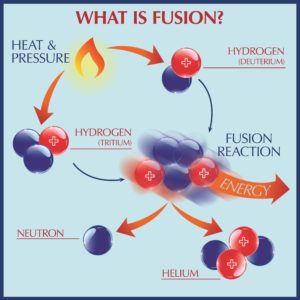What is Fusion Energy?
 Fusion is the power of the sun: at extreme temperatures and pressures, atoms collide and “fuse” – releasing huge amounts of energy in the process. At the heart of fusion energy is Einstein’s famous equation, E=MC2 where Energy = Mass x the speed of light, squared. That means that even small amounts of mass have a huge amount of intrinsic energy.
Fusion is the power of the sun: at extreme temperatures and pressures, atoms collide and “fuse” – releasing huge amounts of energy in the process. At the heart of fusion energy is Einstein’s famous equation, E=MC2 where Energy = Mass x the speed of light, squared. That means that even small amounts of mass have a huge amount of intrinsic energy.
Fusion releases that intrinsic energy. Fusion energy is obtained by forcing together atomic nuclei, breaking the nuclear force repelling the atoms from each other, releasing a tremendous amount of energy.
The most common form of fusion comes by fusing types of hydrogen – deuterium and tritium – creating helium and a spare neutron. Other fusion combinations are also being experimented on.
A single gram of fuel can yield 90,000-kilowatt hours of energy. Put another way, it would take 10 million pounds of coal to yield as much energy as one pound of fusion fuel.
In a commercial reactor, this energy will be available as heat to make steam to run a conventional electric generator.
